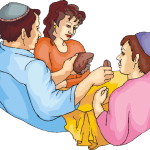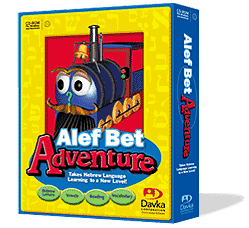 This is one family’s view of their homeschooling approach in Limudei Kodesh. It is by no means the only approach available for homeschoolers. If you would like to know what they do, read on.
This is one family’s view of their homeschooling approach in Limudei Kodesh. It is by no means the only approach available for homeschoolers. If you would like to know what they do, read on.
Pre-school
Homeschooling pre-schoolers is the most enjoyable time to be shared by both parents and their beloved neshamos entrusted to them. Like an infant, pre-schoolers are most curious about what life has to offer. There is so much to learn but learning is not by dry text, but by doing and having enjoyment from it too. Parents’ involvement in homeschooling pre-schoolers is a total commitment.

Alef Bet Adventure CD for learning how to recognize & pronounce the letters in the Hebrew Alphabet in various accents
There are many resources for acquiring Limudei Kodesh skills, thanks to technology. Audio and video resources for learning abound. This stage of acquiring a new language by immersion is also natural. Pre-schoolers enjoy mimicking their caregivers (hopefully, it’s their own parents), so sharing davening time with the children will be beneficial in the long run. Sing out simple prayers together. Do the rituals together, like al netilas yadayim, reciting Modeh Ani, Shema, Berachos before and after eating. This will acclimate your child and train him according to his way, as Shlomo HaMelech advocated, so that he will not veer far from it.
Read the abbreviated version of the weekly parasha together. Supplement it with enjoyable crafts and activities from the theme of the parasha. For example, make a cake in the form of Noach’s ark for Shabbos. Make a simple tent for Parashas Lech Lecha. Bake challahs together.
If you run out of ideas, you can always draw and color a picture downloaded from one of the many Torah educational websites.
Elementary School
This is where it starts to get more serious. Learning can still be enjoyable and the parents’ commitment to homeschooling at this stage remains 100 percent. One of the early skills that need to be honed down is the Hebrew Alphabet reading and writing skills. Again, resources abound for acquiring these skills. If the parent feels unqualified, of course, he can hire a professional. But, homeschooling is not only for the child, it is also for the parents. Many homeschoolers learn together what they don’t know, and this includes the parents!
Learning Chumash involves reading Scriptural text in the original Hebrew. A resource I truly recommend is an interlinear siddur (e.g. Metsudah) and an interlinear Chumash (e.g. Metsudah). However, if you want to learn Dikduk, you need a very reliable source and sometimes this cannot be found in a regular Chumash. Resources we trust include Morah Moriah’s Linear Chumash translation approach and Rabbi Winder’s L’shon HaTorah program.
Although Pirkei Avos advocates spending 5 years in Chumash before proceeding to Mishnayos, we must take into account the factors of learning at the time our fathers wrote this valuable advice. Chumash was learned by rote through this method and not by textual translation. The spoken vernacular at the time was Aramaic, which was closer to the original Hebrew than English. Today, our standards differ. Our children have to master their host language, be it English, France, German, or Chinese as well as a second or third language, such as Hebrew. 5 years of perfection in Chumash is probably a stretch, but in a homeschool, learning is a life-time journey, and learning Chumash is a continuous skill that must be acquired for a lifetime, not just for 5 years.
An overview of the weekly parasha will be more in-depth and we recommend The Midrash Says series from Rabbi Moshe Weissman. The questions at the end of every parasha are very helpful in assessing the comprehension of the child. Younger children can be read to by the parents, and the older children can read the parsha by themselves, or the whole family can sit and read together. We have been doing this for all our children for many years and have relished our time spent together learning Torah this way. Which family wouldn’t want to spend quality time with Torah together? Pirkei Avos teaches that this type of activity brings down the Shechina!
 Middle School
Middle School
At this stage, we included learning Rashi in our Chumash curriculum. This is achievable by learning the Rashi script, a printer’s script for publishing Rashi’s commentary alongside Chumash. We learn to decipher Rashi text and explain what he means, with the help of English translation of his commentary which can be found in the Metsudah.
For parents who are well-versed in modern Hebrew, there is a valuable resource to learn Chumash the way our Israeli counterparts do in their local schools. There is a set of well-illustrated workbooks written only in Hebrew called Zorea v’Kotzer (Planting & Reaping) which contains many selected Rashi commentary as well as other commentary.
Besides Chumash, we also focus on the Haftorah, which are lessons from the Tanach that mirror the theme of the weekly parasha. We found Rabbi Moshe Weissman’s The Midrash Says on the Weekly Haftaros a valuable asset in understanding the background behind each haftorah. Often times, we get very confused with the timeline of the events that take place and the characters involved and this set of books truly help to end the confusion. It is also a great resource for a Bar Mitzvah preparation or a Torah shiur.
Boys start to learn Mishnayos, first in Mishnaic Hebrew, a style different than Chumash Hebrew. There are good resources for learning this as well. Being able to translate Mishnaic Hebrew to comprehensible English (or your native language) is crucial. Questions often asked include which mishnayos to start with? Eilu Mitzios (‘these are the findings’) is popular. You can find interlinear translations of this perek to English at chinuch.org. At this point, we find focusing in-depth learning to be more important than breadth learning.
Girls focus on Tanach. We use Rabbi Moshe Weissman’s The Family Midrash Says series to help us navigate Tanach, in addition to translating from the actual Tanach text and learning the various commentary. The Book of Daniel is an awesome resource for understanding the hidden meanings of Daniel’s prophecies for the end of days. Metsudah offers individual interlinear books in Tanach as well.
Besides Tanach, girls also focus on understanding the siddur and tehillim. It is a good practice to recite Tehillim together as a family and a wonderful activity for Shabbos. Other girls-related learning include Tznius, Kashrus and how to keep a Kosher home.
High School
At this stage, boys begin to focus on the Gemara, even though they haven’t yet mastered the Mishnayos, which our Avos advocated a 5-year indepth study of Mishnayos. The learning of Gemara at this stage is also b-iyun (in-depth) but is an introductory learning and acquiring of skills needed to navigate the deep and rich sea of the Talmud. We recommend hiring a skilled and patient Rebbe for boys.
Girls at this stage include the study of Modern Jewish history into their curriculum. By modern, we mean post-Biblical (post-Tanach). This would include Megilas Esther and Megilas Rus and anything more modern. A very good resource for learning modern Jewish history (post Destruction of Bayis Sheni) in stages is Rabbi Schloss’ 2000 Years of Jewish History, text and workbook set.
 All Time Learning
All Time Learning
We make it a habit to learn halachos together as a family, and this can be done at mealtime during the week and Shabbos. Shmiras Halashon and the 39 Melachos of Shabbos have been popular in our home. What do you learn together as a family unit?














